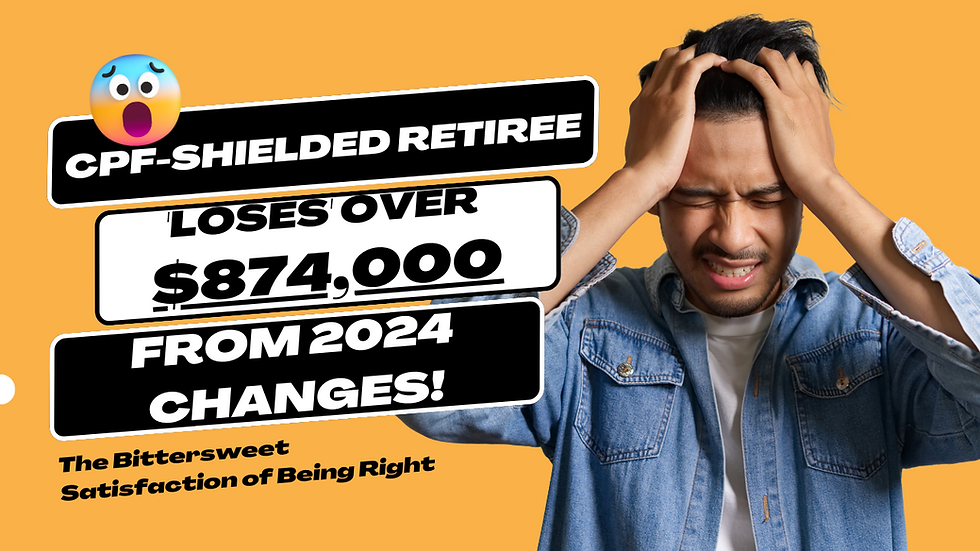Do you know if you can handle these 4 psychological problems of BTIR?
- Money Maverick

- Sep 12, 2019
- 4 min read
Updated: Feb 9, 2023
When it comes to investing and insurance, a concept you've likely come across is Buying Term and Investing the Rest (BTIR). BTIR is a strategy that gives you the opportunity to beat a whole life (WL) insurance plan. Here's how it works.
Plan 1: WL plan with sum assured (SA) $100k and annual premium $3k.
Plan 2: Term plan with SA $100k, annual premium $300, and lasting 20 years.
If you invest the difference ($2.7k) over the 20 years and eventually end up with, say, $135k, you have beaten the WL plan. You have covered your own $100k insurance and made $35k in excess. However, this hinges on you having enough money to have bought the WL plan in the first place, followed by the discipline to keep investing the difference, no matter what temptations life throws at you across the 20 years (or often more).
In theory, the BTIR sounds like a sure-win to beat a WL's returns. In reality, not so much.
And if you bought the term because you did not have money for a WL, that's not BTIR.
Before we jump in, let me clarify that this is not a BTIR versus WL article. That's for another day. Here, I focus solely on the limitations of BTIR that people often forget/neglect. When people think about BTIR, the first question they always ask is, "Can it beat a WL plan?"
However, they forget to consider the inherent flaws of the strategy itself. I've put together four problems of BTIR that you should consider before you proceed with your own BTIR.
1. Volatility Risk
Volatility is quite the fickle thing, you can never really predict when a market crash happens.
Say you want to beat Plan 1's $100k SA so you BTIR Plan 2. Your investments do really well across the 20 years, your portfolio value grows to $150k and you're really happy about it. Suddenly there's a downturn. Your portfolio value plummets to $55k and before the market can recover, you die. What you're passing on to the people who need it most is suddenly almost half what it was meant to be.
When people BTIR, it's usually because they want to stay secure while they're earning investment returns for a very specific purpose (family, education etc). Chances are, that lower protection amount is not going to be enough. To make matters worse, you likely can't even insure yourself anymore.
It’s going to affect you and the people the money was supposed to go to. And that’s going to be on you.
2. Mental Faculty Risk
Across that 20 year investment period, you’re going to have to invest and you’re going to have to invest well. But one of the problems that we’re facing in today's age is the increasing numbers of dementia and Alzheimer’s, early diagnosis in particular.
The BTIR strategy hinges on the assumption that you are going to be able to invest as well in the next 20 years as you are today but that may not be the case. Most of us expect to improve on something the more we practice but investing is a skill that requires a lot of mental energy.

Aside from re-balancing, budgeting and resisting the urge to spend that money on everything under the sun - including legitimate emergencies - you have to consider extenuating factors like health and mid-life crises as well. Factor all those in and your ability to invest is most certainly going to be negatively affected. The investment decisions you make are a lot more likely to be based on emotion rather than objective logic.
This becomes worse with a long investment period because your investment acumen, and your risk profile as a 70-year-old, is not going to be the same as when you were 30.
3. Quantitative value of time
This is one of the biggest risks people fail to consider.
There are studies that indicate that the time you have as a youngster is considerably less valuable than the time you have as an adult. When you’re young, you tend to do all sorts of stupid crap and waste a lot of time. As you grow older, you have commitments from aging parents to a new family. The time you have now is limited.

Chances are, you have a decent career as well so you’re going to be making more money at 45 than you were at 20. This means that your time as 45-year-old is a lot more expensive than it was at 20.
When people BTIR, they invest based on the assumption that their time now is worth the same as it is later. They believe that they can spend X amount of minutes every week on their investments and that it'll be same later as it is now.
But the reality is that this commitment is going to have an effect. There's an opportunity cost because you could be doing a job that gives you a much higher ROI than just trying to make sure your investments beat the insurance returns. Or what if you want to spend time with family, time considered invaluable?

Many people don’t realise that their time gets increasingly important, and this leads them to neglect the future potential value of their time,
4. Spender / Emotional Risk
This risk kicks in if you choose to invest in something that is super liquid. As mentioned, if investors get very emotional about something or if they need the money for an emergency, there's a very high chance they would withdraw their investments, thereby compromising on their returns.
When you’re trying to beat a WL plan, the last thing you want to do is compromise your investment returns. Otherwise there is absolutely no way that you’re going to be able to grow your portfolio back up.

Deciding if you should buy term and invest the rest is not as easy as answering the 'Can it beat the WL version' question. There are varying results for WL versus Term which depend on things like riders, multipliers, the limited pay period, the likely investment returns by yourself and the insurer, etc.
Sure, with the right investments, it may be able to beat the WL but can you commit to the long-term effort?
If you enjoyed the article or have some thoughts or comments on how you can start developing your streams of income, do like - comment and subscribe!
Money Maverick
#honestopinion #btir #buyterminvesttherest #terminsurancesingaporecomparison #buytermandinvestthedifferencemyth #insurance #investing #insurancesingapore #financialplanning #whereshouldIstart #moneymaverick






תגובות